David was a dream to work with. He really listened to our descriptions of what we wanted including a modern aesthetic. We went through multiple iterations, during which his facility with CAD architecture software was very helpful along with his other skills. We interviewed 3 architects including David. One thing his references all said, which we found to be true, is that he will build the house you want, not the house he wants. From looking at some of his other work it’s clear he’s very versatile. We also found David to be very professional and business-oriented; his contract and fee structure were clear and easy to understand; there were no surprises. David also helped us choose our contractor from three competitors (ultimately, we chose Dave Deveau and were also very happy with him and his work). Finally, David also advised us during the construction process including, of course, some design changes we asked for (after all, one of the benefits of building a custom home is that you can change things as you go along). All in all, we’re very pleased with the home David designed for us.
Owners Judith and John
Set into an east-facing hillside overlooking the town of Sonoma, this custom house focuses on view, ventilation, and controlled solar access, while providing a contemporary lifestyle for a retired couple. Each design decision was made with attention paid to how the result affects function, aesthetics, and livability in the home.
The clients came to David Marlatt and his team with three ideas in mind. They were looking to build their retirement home on a gorgeous lot with amazing East-facing views. They needed their home to be 1) ready for aging, 2) incredibly energy efficient; and 3) aesthetically, they wanted their home to be in harmony with the surrounding hillsides and integrated into the natural landscape.
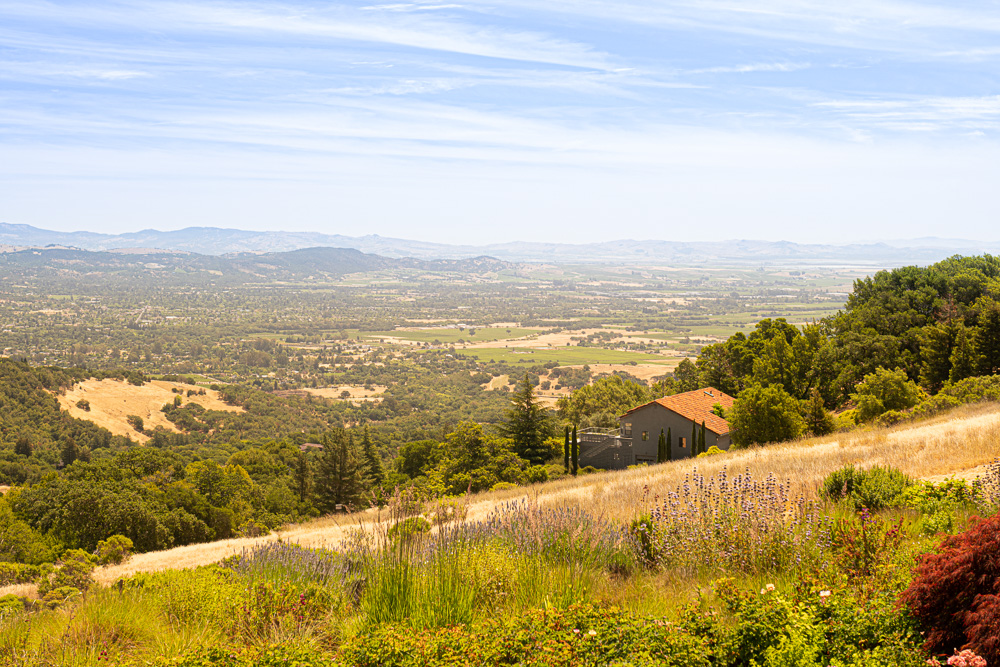
To address the desire for high energy efficiency, the home was designed to consume “near net-zero” energy. The end result is a Green Point Certified House (Platinum level with 188 points) and employs Premier SIPs (Structural Insulated Panels), ICFs (Insulated Concrete Forms), and other passive and active strategies – all of which contribute to a minimal need for air conditioning in the summer and heating in the winter. The home averaged a total daily energy use of 57KwH in the first 10 months of occupancy… 33KwH of that was supplied by the home’s own solar energy!
In addition, the home utilizes a personal water storage system; four 5,000-gallon, above-ground water storage tanks (20,000 gallons total) are located on a hillside below the house. The harvested rainwater contributes to irrigation, reducing the use of city water which is especially important in drought years.
To provide the clients with the aesthetically-pleasing exterior they asked for, the home’s placement on the land and intentionally-designed folded roof respect and recall the topography of the surrounding Sonoma County hills; its shallow depth maximizes the panoramic views and cross-ventilation from afternoon ocean air. David and his team ran airflow simulation tests through the house during the design process, ensuring that no dead-air spaces would be built. The folded roof also maximizes the home’s ability to site solar panels, increasing the electric production to its fullest potential.
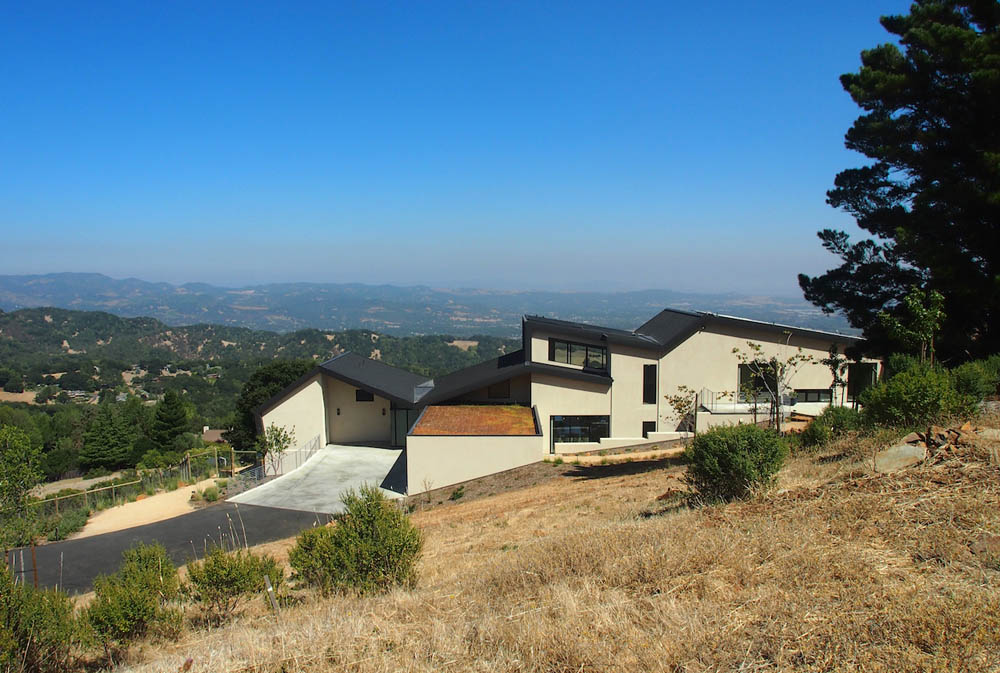
Finally, to address the aging in place requirement, the home is organized almost entirely on a single level, with only storage and open office space on the upper floor. Two 5-foot square stacking closets are prepped for a future elevator; doors have lever handles and are sized at major spaces to accommodate a future wheelchair; and an attached dwelling unit can be converted into a future care giver’s apartment.
As you enter the home, the pivoting front door brings visitors into the home’s entry hallway. This compressed space shows light at the end of the “tunnel,” pulling all who enter forward. The poured-in-place polished concrete flooring that runs throughout the home is not just a gorgeous design choice, it is also zero-maintenance and provides a thermal mass to help modulate temperature swings.
There are two rooms and a full bathroom at the front entrance, currently serving as a hobby room and an exercise/media room. One has a murphy bed already installed, but both could easily be transformed into bedrooms for extended family visits.
The full bathroom gives the first look at a design choice repeated in each bathroom: a door in the shower that provides entry to the back patio/ pool deck for quick access after a swim or the ability to use a restroom without dripping water through the home.

Walking down the hall, visitors are pulled into the home’s great room, which combines living room, kitchen, and adjacent dining area. The ceiling here is two-stories tall and there is evidence of one of the main energy design strategies here. The home is only one room deep. Thus, the owners can open both sides of any room to get amazing cross ventilation. The Pacific lies about five miles to the west, and the afternoons bring cool ocean air from that flows right through the home. Because of this intuitive design, the air conditioner is rarely utilized, despite the sometimes-warm California climate. In fact, the home often produces more energy that it uses, even in the summer!
Western Window Systems are used throughout for the many sliding glass doors and windows. In the main living space, the large sliding doors that slide into a pocket provide an instant connection to the east-facing deck and the grand sweeping views of the surrounding California hills. Additional windows at the second story height above the sliding doors allow immense natural light to pour into the space. On the other side of the room, a three-pane glass door slides and stacks to provide cross ventilation and a connection to the home’s west landscape.
The beautiful millwork and use of wood throughout the home adds to the contemporary feel, especially the two-story wall in the living room, which has been paneled with a maple veneer. Likewise, the cabinetry and shelves (found throughout the home) are all maple and built by Dugan Cabinetry.
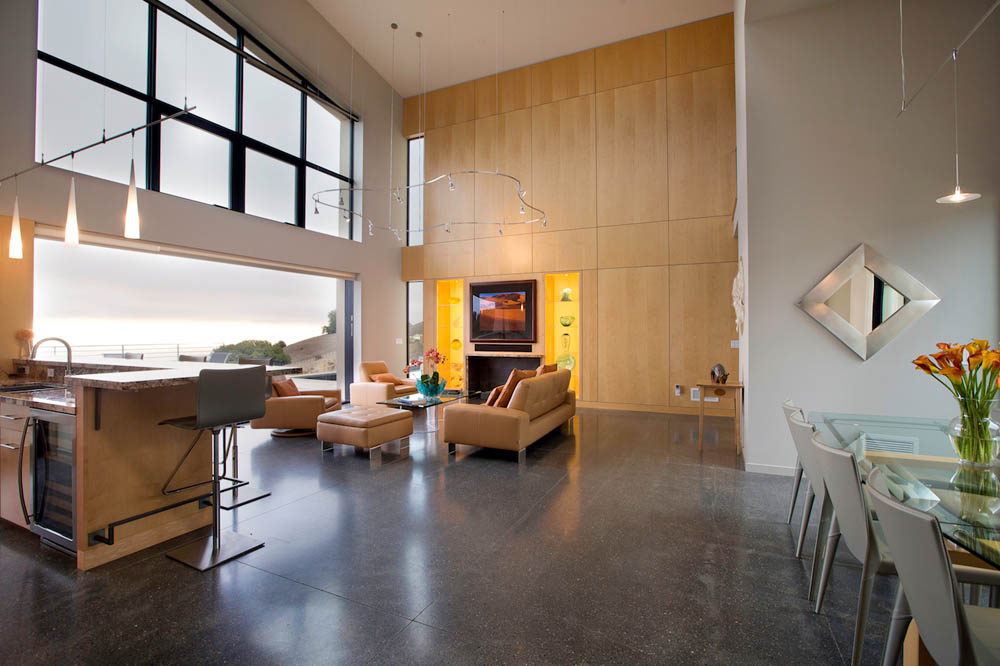
The kitchen is modest in its size, but grand in its functionality. The real standout design choice is the implementation of a “front kitchen.” While the main kitchen has all major appliances and plenty of counter space, a kitchen peninsula is pushed forward just a bit into the living space and holds a coffee bar, wine refrigerator, sink, and plenty of storage and counter space. Perfect for entertaining, this structure can also serve as a bar and service area while the host can stay connected to guests.
The peninsula is separated from the kitchen by a small door that provides quick indoor/outdoor access for the chef/host. The peninsula’s countertop runs up to the sliding glass doors and continues through to form an outside bar. The glass door slides into a cutout made in the countertops, providing a seamless transition of indoor/outdoor entertaining space.
The east-facing deck extends the full length of the home. In addition to the bar, it is equipped with a cozy firepit seating area, outdoor kitchen with full barbeque station, dining area, and a pool.
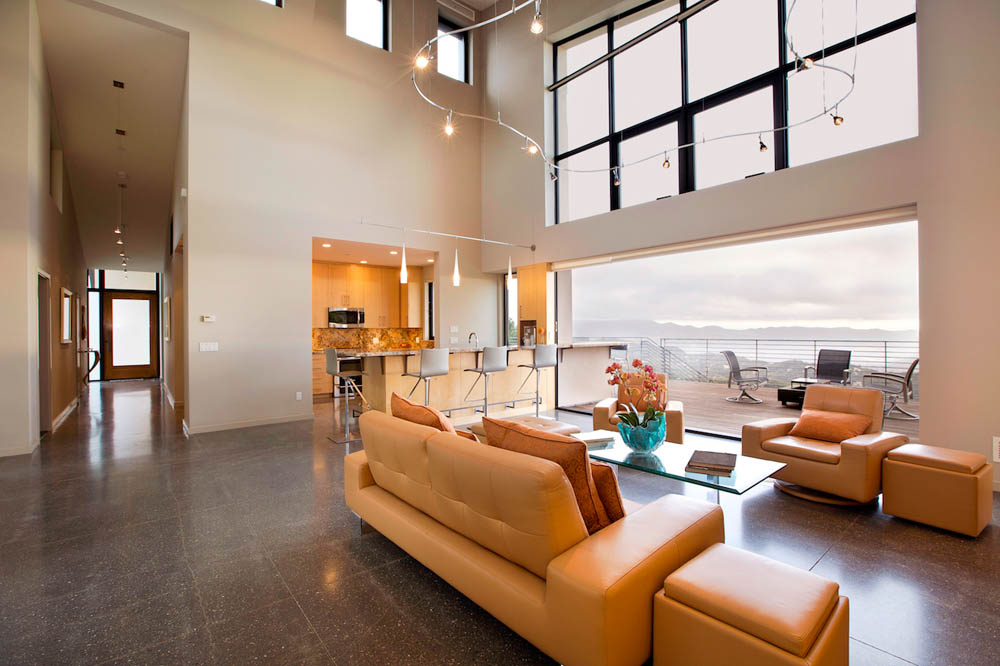
Moving out of the main living space, the home continues down a hallway into the private area of the home. Two bedrooms were designed as dual suites, though the bedroom at the end of the hall is slightly larger. Each room is connected to an office space above (an open, mezzanine-style overlook) and a stairway to the upper floor; the latter effectively divides the space in half and separates the two suites.
The bedrooms have two-story ceilings and east-facing windows at the second-floor level to bring in the natural light. The awning windows above open to expel hot air in the summer months and allow the cooling winds to flow in at night.
Each suite is equipped with its own full bathroom and walk-in closet, and each has access to the east-facing deck and pool via sliding glass doors. As seen earlier, each bathroom also has its own shower door to the outside, providing quick access to a post-swim shower or mid-swim relief.
The only stairs in the home lead up a secluded, straight hallway that is completely lit by two-story floor-to-ceiling windows. At the top, visitors can go in three directions: straight ahead through sliding glass doors to a small patio at the west side of the home, which, due to the topography, is just slightly above ground level; to the right into the first suite’s office area; or to the left into the master suite’s mezzanine and office balcony. Both office spaces have access to their own private second floor terrace on the east side of the home.
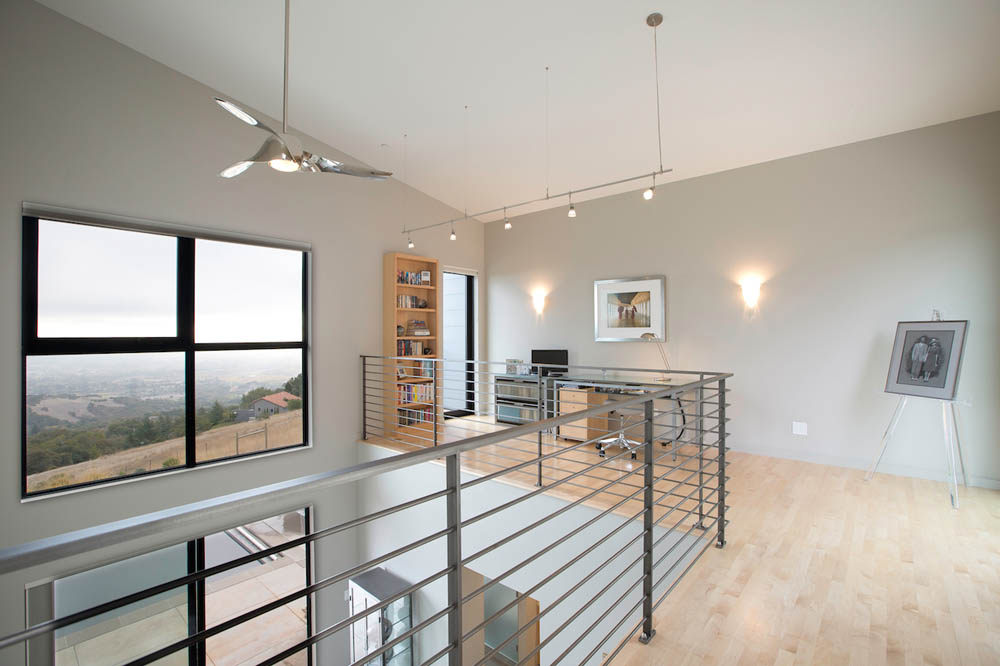
This stunning modern home in Sonoma is the end result of a wonderful collaboration between DNM Architecture, Deveau Construction, and an amazing couple. This forever home celebrates contemporary design and ultra-green building techniques, while capitalizing on magnificent, panoramic views that make life on this sunny Sonoma hillside a never-ending dreamscape.
Home Images: Joseph Schell
Landscape Image: Jamie Leasure
